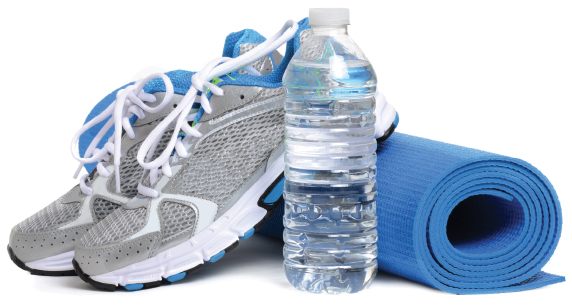The ASCO Post’s Integrative Oncology series is intended to facilitate the availability of evidence-based information on integrative and complementary therapies sometimes used by patients with cancer. Accumulating evidence suggests the benefits of physical activity through the cancer continuum. However, many patients have difficulty engaging in exercise because of surgical complications or treatment-related side effects, such as fatigue and pain. In this article, Justin Brown, PhD, summarizes the key points oncologists should know about physical activity in cancer care as well as the importance of communicating them effectively to patients.

Justin Brown, PhD
Approximately 85% of patients with cancer do not adhere to regular physical activity for optimal health.1 There is growing scientific interest in determining ways of using physical activity to improve how patients with cancer feel, function, and survive.2 This interest is motivated, in part, by patients’ curiosity to understand how their individual health behaviors may influence important outcomes.3 Therefore, efforts to increase physical activity among patients will significantly improve individual and population health. So, what are the key messages for oncologists, and what should oncologists tell patients?
Benefits of Physical Activity
Physical activity improves how patients with cancer feel and function. A meta-analysis of 34 randomized controlled trials involving 4,514 patients with cancer revealed that physical activity improved health-related quality of life and physical functioning.4 Physical activity also reduced cancer-related fatigue5 and were beneficial both during and after completion of active cancer therapy. Also, supervised exercise programs were reported to be more efficacious than unsupervised ones.4,5

Furthermore, physical activity may improve survival. A systematic review of meta-analyses concluded that physical activity was associated with a lower risk of all-cause and cancer-specific mortality among patients diagnosed with early-stage breast, colorectal, and prostate cancers.6 The biologic mechanisms that underpin this association, if causal in nature, may include metabolic growth factors, inflammation, immune function, and proteins secreted by muscle and adipose tissue.7
In addition, physical activity improves a variety of other clinically relevant outcomes. As more patients are cured of cancer, cardiovascular disease and diabetes will emerge as competing causes of morbidity and mortality. In studies involving patients with cancer, physical activity has been shown to increase cardiovascular fitness capacity and improve body composition,8,9 both strong risk factors for cardiovascular events (eg, myocardial infarction and stroke) and type 2 diabetes mellitus.10,11
Current Guidelines for Physical Activity
The Department of Health and Human Services published the second edition of the Physical Activity Guidelines for Americans in 2018.12 Below are the key recommendations applicable to everyone,
including patients with cancer:
1) Sit less throughout the day. Some physical activity is better than no activity. Avoid prolonged intervals of inactivity. Patients who sit less and do some physical activity gain health benefits when compared with those who remain inactive.
2) For extensive improvements in health, at least 150 minutes of moderate-intensity or at least 75 minutes of vigorous-intensity aerobic physical activity is recommended each week. Aerobic physical activity should be spread over the week, if feasible.
3) When 150 minutes of moderate-intensity aerobic physical activity each week cannot be achieved, due to acute or chronic conditions, be as physically active as abilities and conditions permit.
4) By accumulating at least 300 minutes of moderate-intensity physical activity each week, additional health benefits are gained.
5) Resistance and muscle strengthening exercises provide health benefits distinct from those attained with aerobic physical activity.
6) Older adult patients and those at risk for functional limitation should also perform balance and flexibility activity on days that other physical activity is performed (eg, stretching prior to aerobic physical activity).
Multiple organizations, including the American Cancer Society and the National Comprehensive Cancer Network, have endorsed similar guidelines for physical activity.13,14
How Can Oncologists Integrate Physical Activity Into Practice?
GUEST EDITOR

Jun J. Mao, MD, MSCE
A recent survey conducted by ASCO indicated that almost 80% of oncologists agree on recommending physical activity to patients.15 Of note, however, respondents acknowledged several barriers to promoting physical activity, including lack of time, limited reimbursement, insufficient training or expertise, or inadequate resources for referrals.15
To facilitate greater integration of physical activity into clinical care for the management of chronic disease, the American College of Sports Medicine developed the “Exercise Is Medicine Initiative,” which is now applicable to patients with cancer.16 Although the initiative recognizes the various constraints faced in clinical practice, three steps are recommended to promote incorporating physical activity into clinical care:
1) Assess: Asking about physical activity conveys to patients that their physician believes in the importance of physical activity.
2) Advise: Encouraging patients to become physically active, as able, fosters patient understanding that physical activity is an important contributor to optimal health.
3) Refer: Connecting patients to appropriate and effective information and services can assist and initiate changes in their behaviors.
Oncologists can provide patients with educational materials to ensure a basic understanding of physical activity recommendations (https://bit.ly/2XXHiPg). They can also refer patients to evidence-based community resources, such as LIVESTRONG at the YMCA, which is currently offered at 791 locations nationally (https://bit.ly/3cOGgcB).17 For patients who seek individualized guidance, the American College of Sports Medicine created a subspecialty certification to enable qualified personal trainers to provide counseling; there are currently 500 trainers nationally who are cancer-certified and can be contacted by patients or physicians (https://bit.ly/2NcESr1). Patients with physical impairments that impede activity or make activity unsafe should be referred to physical therapy.18
Patients with cancer should avoid inactivity. Oncologists are uniquely positioned to promote patient awareness about the benefits of physical activity.
Dr. Brown is Assistant Professor and Director, Cancer Metabolism Program, Pennington Biomedical Research Center of LSU, Baton Rouge, Louisiana.
DISCLOSURE: Dr. Brown has received institutional research grant support from the National Institutes of Health and the American Institute for Cancer Research.
REFERENCES
1. McDonald L, Oguz M, Carroll R, et al: Comparison of accelerometer-derived physical activity levels between individuals with and without cancer: A UK Biobank study. Future Oncol 15:3763-3774, 2019.
2. Alfano CM, Bluethmann SM, Tesauro G, et al: NCI funding trends and priorities in physical activity and energy balance research among cancer survivors. J Natl Cancer Inst 108:djv285, 2016.
3. Demark-Wahnefried W, Peterson B, McBride C, et al: Current health behaviors and readiness to pursue life-style changes among men and women diagnosed with early stage prostate and breast carcinomas. Cancer 88:674-684, 2000.
4. Buffart LM, Kalter J, Sweegers MG, et al: Effects and moderators of exercise on quality of life and physical function in patients with cancer: An individual patient data meta-analysis of 34 RCTs. Cancer Treat Rev 52:91-104, 2017.
5. Van Vulpen JK, Sweegers MG, Peeters PHM, et al: Moderators of exercise effects on cancer-related fatigue: A meta-analysis of individual patient data. Med Sci Sports Exerc 52:303-314, 2020.
6. McTiernan A, Friedenreich CM, Katzmarzyk PT, et al: Physical activity in cancer prevention and survival: A systematic review. Med Sci Sports Exerc 51:1252-1261, 2019.
7. Brown JC, Gilmore LA: Physical activity reduces the risk of recurrence and mortality in cancer patients. Exerc Sport Sci Rev 48:67-73, 2020.
8. Strasser B, Steindorf K, Wiskemann J, et al: Impact of resistance training in cancer survivors: a meta-analysis. Med Sci Sports Exerc 45:2080-2090, 2013.
9. Scott JM, Zabor EC, Schwitzer E, et al: Efficacy of exercise therapy on cardiorespiratory fitness in patients with cancer: A systematic review and meta-analysis. J Clin Oncol 36:2297-2305, 2018.
10. Knowler WC, Barrett-Connor E, Fowler SE, et al: Reduction in the incidence of type 2 diabetes with lifestyle intervention or metformin. N Engl J Med 346:393-403, 2002.
11. Look ARG, Wing RR, Bolin P, et al: Cardiovascular effects of intensive lifestyle intervention in type 2 diabetes. N Engl J Med 369:145-154, 2013.
12. Piercy KL, Troiano RP, Ballard RM, et al: The physical activity guidelines for Americans. JAMA 320:2020-2028, 2018.
13. Rock CL, Doyle C, Demark-Wahnefried W, et al: Nutrition and physical activity guidelines for cancer survivors. CA Cancer J Clin 62:243-274, 2012.
14. Denlinger CS, Sanft T, Baker KS, et al: NCCN Clinical Practice Guidelines in Oncology: Survivorship, version 2.2018. J Natl Compr Canc Netw 16:1216-1247, 2018.
15. Ligibel JA, Jones LW, Brewster AM, et al: Oncologists’ attitudes and practice of addressing diet, physical activity, and weight management with patients with cancer: Findings of an ASCO Survey of the Oncology Workforce. J Oncol Pract 15:e520-e528, 2019.
16. Schmitz KH, Campbell AM, Stuiver MM, et al: Exercise is medicine in oncology: Engaging clinicians to help patients move through cancer. CA Cancer J Clin 69:468-484, 2019.
17. Irwin ML, Cartmel B, Harrigan M, et al: Effect of the LIVESTRONG at the YMCA exercise program on physical activity, fitness, quality of life, and fatigue in cancer survivors. Cancer 123:1249-1258, 2017.
18. Silver JK, Baima J, Mayer RS: Impairment-driven cancer rehabilitation: An essential component of quality care and survivorship. CA Cancer J Clin 63:295-317, 2013.

